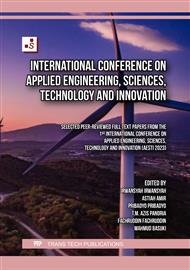[1]
A. Sam and D. Patabang, "Studi Potensi Energi Angin Di Kota Palu Untuk Membangkitkan Energi Listrik," SMARTek, vol. 3, no. 1, 2005.
DOI: 10.25299/jrec.2021.vol3(2).7165
Google Scholar
[2]
H. Djojodiharjo, "Pengantar Ringkas Sistem Listrik Tenaga Surya," Inst. Teknol. Bandung, Bandung, 2001.
Google Scholar
[3]
A. P. Tampubolon, J. C. Adiatma, F. Tumiwa, and J. Giwangkara, "Laporan Status Energi Bersih Indonesia," IESR, Jakarta, 2019.
Google Scholar
[4]
I. Daut, M. Irwanto, Y. M. Irwan, N. Gomesh, N. S. Ahmad, and others, "Potential of wind speed for wind power generation in Perlis, Northern Malaysia," Telkomnika, vol. 9, no. 3, p.575, 2011.
DOI: 10.12928/telkomnika.v9i3.750
Google Scholar
[5]
Y. Daryanto, "Kajian potensi angin untuk pembangkit listrik tenaga bayu," 2007.
Google Scholar
[6]
A. Hasibuan, W.V. Siregar, A. Setiawan, and M. Daud, "Pemanfaatan Energi Bayu Sebagai Sumber Energi Listrik Untuk Penerangan Pada Perahu Nelayan," RELE (Rekayasa Elektr. dan Energi) J. Tek. Elektro, vol. 3, no. 2, p.85–88, 2021.
DOI: 10.30596/rele.v5i1.10788
Google Scholar
[7]
M. R. Fachri and H. Hendrayana, "Analisa Potensi Energi Angin dengan Distribusi Weibull Untuk Pembangkit Listrik Tenaga Bayu (PLTB) Banda Aceh," CIRCUIT J. Ilm. Pendidik. Tek. Elektro, vol. 1, no. 1, 2017.
DOI: 10.22373/crc.v1i1.1377
Google Scholar
[8]
A. Hasibuan, S. Masri, and W. Othman, "Effect of distributed generation installation on power loss using genetic algorithm method," in IOP Conference Series: Materials Science and Engineering, 2018, vol. 308, no. 1, p.12034.
DOI: 10.1088/1757-899x/308/1/012034
Google Scholar
[9]
B. P. P. DAERAH, "DESAIN AWAL TURBIN ANGIN LEPAS PANTAI DI GAMPONG ALUE NAGA."
Google Scholar
[10]
E. S. Maladeni and A. Ishak, "Kelayakan Pengembangan Teknologi Elektirifikasi Pedesaan di Pesisir dan Pulau-Pulau Kecil Melalui Pembangkit Listrik Tenaga Angin (PLTB) Di Kabupaten Wakatobi," SCEJ (Shell Civ. Eng. Journal), vol. 6, no. 1, p.11–22, 2021.
DOI: 10.35326/scej.v6i1.1298
Google Scholar
[11]
M. Padmika, I. M. S. Wibawa, and N. L. P. Trisnawati, "Perancangan pembangkit listrik tenaga angin dengan turbin ventilator sebagai penggerak generator," Bul. Fis. Univ. Udayana, vol. 18, no. 2, p.68–73, 2017.
DOI: 10.24843/bf.2017.v18.i02.p05
Google Scholar
[12]
M. N. Habibie, A. Sasmito, and R. Kurniawan, "Kajian Potensi Energi Angin di Wilayah Sulawesi dan Maluku," J. Meteorol. dan Geofis., vol. 12, no. 2, 2011.
DOI: 10.31172/jmg.v12i2.99
Google Scholar
[13]
A. Nelwan, "Karakteristik Weibull Pltb Miangas," J. Tek. Elektro dan Komput., vol. 1, no. 1, 2012.
Google Scholar
[14]
D. Atef, H. Osman, M. Ibrahim, and K. Nassar, "A simulation-based planning system for wind turbine construction," in Proceedings of the 2010 Winter Simulation Conference, 2010, p.3283–3294.
DOI: 10.1109/wsc.2010.5679020
Google Scholar
[15]
M. I. Arsyad, F. Imansyah, J. Marpaung, and R. Ratiandi, "Pengembangan Teknologi Pembangkit Listrik Tenaga Angin Untuk Nelayan Guna Meningkatkan Kapasitas Ikan Tangkapan," J. Pengabdi, vol. 4, no. 1, p.62–74, 2021.
DOI: 10.26418/jplp2km.v4i1.44472
Google Scholar
[16]
D. Notosudjono, "Teknologi Energi Terbarukan," Bogor Unpak Press. Bogor, 2017.
Google Scholar
[17]
R. Yunginger and N. S. Nawir, "Analisis Energi Angin Sebagai Energi Alternatif Pembangkit Listrik Di Kota Di Gorontalo," Univ. Negeri Gorontalo, vol. 15, p.1–15, 2015.
DOI: 10.32502/jse.v6i1.3364
Google Scholar
[18]
Z. Tharo, H. Hamdani, and M. Andriana, "Pembangkit listrik hybrid tenaga surya dan angin sebagai sumber alternatif menghadapi krisis energi fosil di sumatera," in seminar nasional teknik (SEMNASTEK) UISU, 2019, vol. 2, no. 1, p.141–144.
DOI: 10.24036/jtev.v5i1.1.107374
Google Scholar
[19]
R. T. Jurnal, "Analisis Kelayakan Turbin Angin Kecepatan Rendah Tipe NT1000W di Wilayah terpencil," Energi \& Kelistrikan, vol. 10, no. 1, p.84–93, 2018.
DOI: 10.33322/energi.v10i1.332
Google Scholar
[20]
A. Hasibuan, M. Daud, M. Sayuti, F. Hidayatullah, W. V. Siregar, and R. Fachroji, "Utilization of Small Wind Turbines as Source Alternative Electrical Energy for Lighting in the Banyak Island Tourism Area, Aceh Singkil, Indonesia," in 2022 6th International Conference on Electrical, Telecommunication and Computer Engineering (ELTICOM), 2022, p.44–47.
DOI: 10.1109/elticom57747.2022.10037795
Google Scholar


